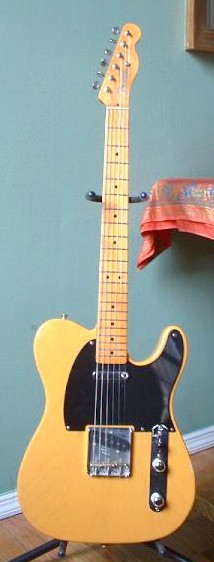Actually, the Fender Telecaster is just purely & simply a legendary guitar—when you talk about solid-body electrics, the conversation always seems to start with three: the Fender Telecaster & Stratocaster & the Gibson Les Paul. All three guitars have made a huge impact on music since the mid 20th century—& each has also made huge impact on guitar design. The Telecaster was the earliest of the three, with a prototype known as the Broadcaster being available in the late 1940s, & the Telecaster itself going into distribution late in 1950. A companion model, the Esquire, also went into production at this time. The Esquires only had a single pick-up, whereas the Telecaster has two, one in the neck position & one in the bridge.
Leo Fender, who designed & built the Telecaster, incorporated a number of innovations that have since gone into widespread use with other models of solid-body electric guitars. For the uninitiated, “solid body” refers to the fact that the guitar’s body is a solid block of wood rather than a hollow sound chamber as is found in an acoustic guitar or a “hollow body electric.” When you think “electric guitar,” odds are what you picture in your mind is a solid body guitar.
While Leo Fender’s construction techniques were important—& if you’re interested in this, Wikipedia has a good article on the Telecaster here—the thing we all know is the sound. Again, to refer to Wikipedia, which gives a nice thumbnail on this:
The Telecaster is known for its ability to produce both bright, rich, cutting tone or mellow, warm, bluesy tone depending on the selected pickup, respectively "bridge" pickup or "neck" pickup... [making] the Telecaster a versatile guitar, usable for most styles of music including country, blues, rock and jazz.
Yes, even in jazz! One doesn’t think of jazz guitarists as playing solid-body electrics, but noted jazz player Bill Frisell has used a Telecaster as his main guitar for years! Noted Telecaster players have also included players as diverse as Merle Haggard, David Gilmour, Bruce Springsteen & Joe Strummer—just to name a few.
But we’re interested specifically in the Telecaster being used in the blues, & there are some top-notch players in that field as well. Albert Collins—the “Master of the Telecaster” (see the first video below), Muddy Waters (third video), Roy Buchanan, Snooks Eaglin (second video—amazing!), Robben Ford, Deborah Coleman, Sue Foley—even Keith Richards, who can certainly play some blues, & whose main guitar (named “Micawber”) is a Telecaster strung with only five strings & tuned to open G.
The proof, of course, is in the listening, & today we have three videos—in large part because I had to include both Collins & Waters, but couldn’t pass on the amazing performance by Snooks Eaglin! Hope you enjoy them.

What a great way to start the day - Albert Collins, Snooks Eaglin, and Muddy Waters! I'm a huge Collins fan; the man is my favorite Blues musician. He hot-rodded his Telecaster, and Fender actually put out a limited edition Albert Collins Signature Telecaster based on his personal modifications; I used to know someone who had one. Great post, John!
ReplyDeleteHi Roy: I thought you might like this one! I'd have liked to include more info such as what you refer to, but didn't for two reasons--first, the post would have gotten long, & second, once you start talking about single coil pick-ups & humbuckers etc., I think you start to lose the general reader. But the various ways Teles have been hotrodded is fascinating stuff!
ReplyDeleteBrilliant John, just brilliant!
ReplyDeleteHi Titus: So glad you enjoyed it--thanks!
ReplyDelete